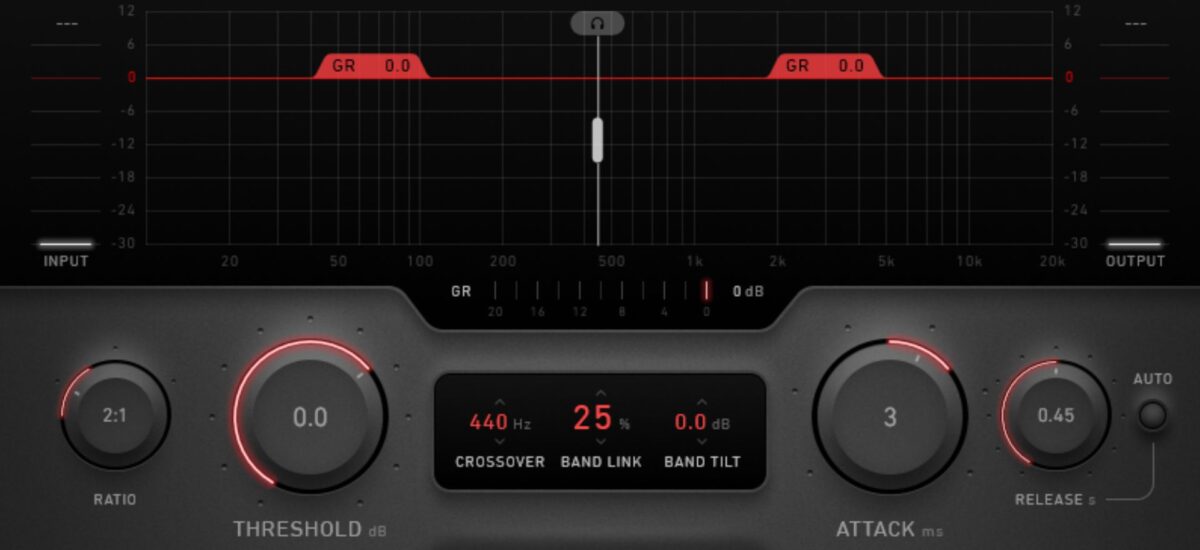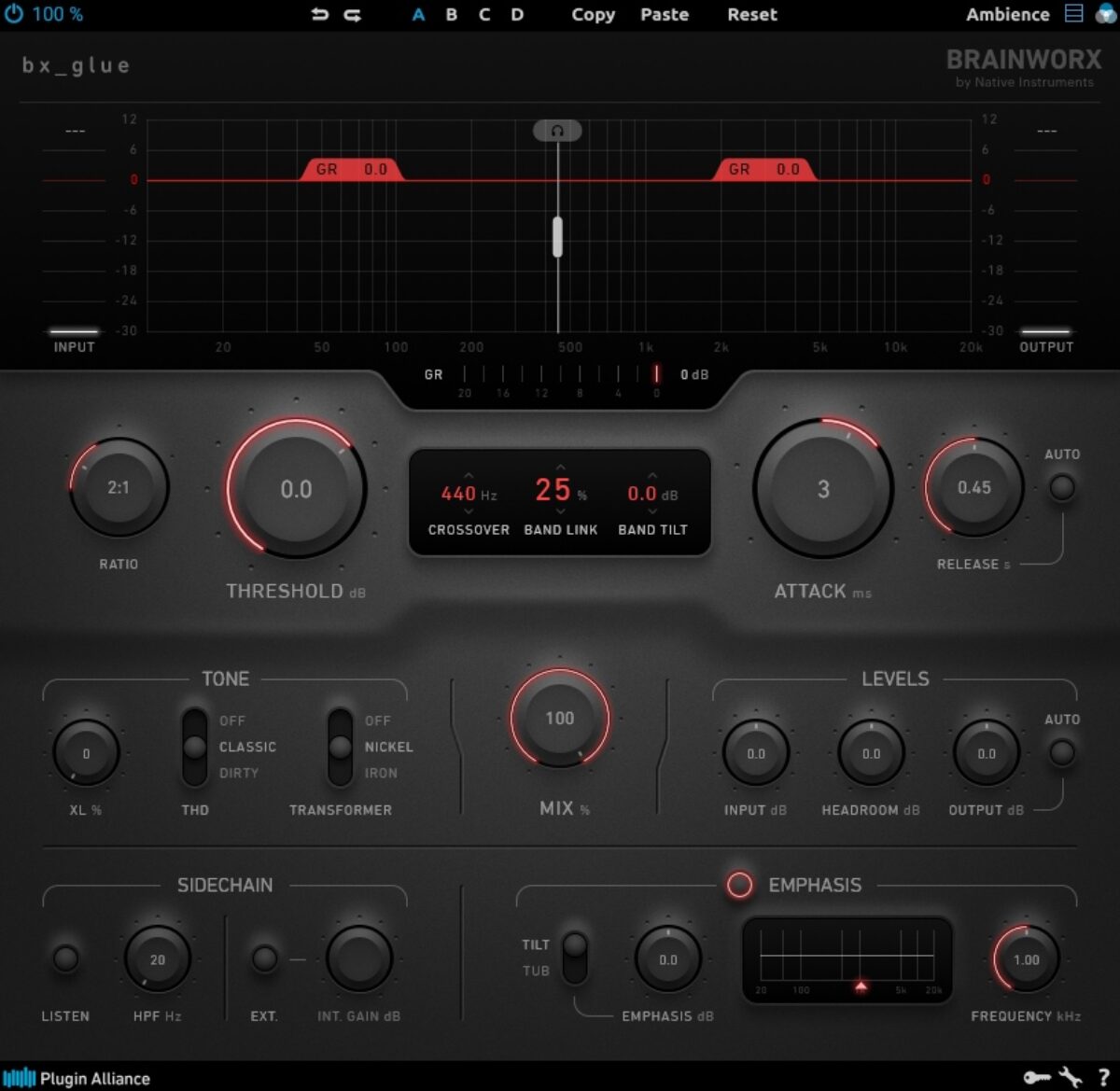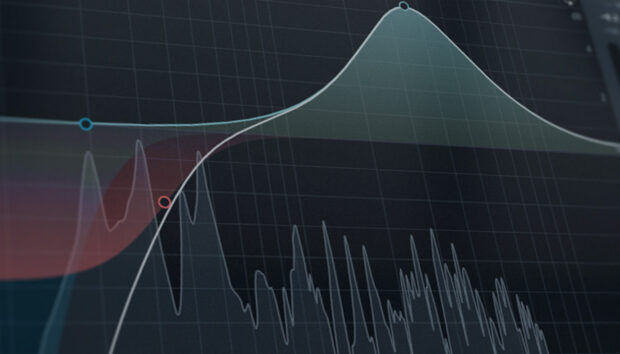
Glue compression could be the missing link between how your mixes currently sound and professional results. Applying glue compression to a song produces a tighter, thicker, richer mix – just what every music producer wants.
This guide covers what a glue compressor does, when you should use a glue compressor, and how to use a glue compressor. We’ll also cover some popular glue compressor plugins you can demo for free.
Jump to these sections:
- What is a glue compressor?
- When should you use a glue compressor?
- How to use a glue compressor plugin
- Popular glue compressor plugins
Follow along by demoing a free MEGA plan trial from Plugin Alliance that gives you access to over 180 professional plugins from 40+ brands.
What is a glue compressor?
A glue compressor applies gain reduction to multiple tracks that have been summed together, leading to a more cohesive sound. When a transient from a single track triggers gain reduction, the entire group is hit with compression. In excess, this can lead to pumping effects, but glue compression is usually applied in moderation to add a sense of togetherness to buses.
You can use any compressor to apply glue compression, but not all compressors are intended for this purpose. Compressors with a long release, like an LA-2A, might work for smooth and melodic tracks but not for punchy and aggressive songs. An 1176 with an ultra-fast attack and release can overcome that issue, but the hardware doesn’t include a sidechain filter, meaning it could respond too aggressively to low-end transients. You may also want to apply multiband processing for a more transparent sound, which omits a wide selection of compressors.
Brainworx bx_glue is designed as a glue compressor with all the bells and whistles you might need. It includes features like a Tone section, Sidechain section, Emphasis section, and Tilt functionality that allow you to sculpt the compression applied precisely.
The Emphasis section in bx_glue is particularly interesting. It emphasizes frequencies pre-compression while de-emphasizing frequencies post-compression. Pre-emphasis causes bx_glue to compress the frequency range you’ve targeted more aggressively, while de-emphasis rebalances the level offset. Use this feature to tame harsh frequencies while minimally affecting the tonal balance of your subgroups and stereo bus.

When should you use a glue compressor?
Glue compression can be applied to instrument groups, vocal buses, or stereo buses. Most groups can benefit from a little glue compression, even if they don’t require significant dynamic range control. The coloration applied by an analog-modeled glue compressor like bx_glue can act like a mix adhesive.
While a compressor isn’t typically considered a spatial effect, a sound’s dynamic range does affect your spatial perception of it. A snare drum being hit one foot away from your ear will appear much more transient than a snare drum hit 100 feet away. There will be inherent level differences if you record these sounds, but if you level match them, you’ll find the nearer snare hit to have a more transient waveform profile.
Dynamic range is just one of the characteristics of a sound that your brain uses for sound source localization. It also relies on timing, frequency, sound pressure levels, and room reflections. Audio compression subtly affects the spatial perception of a sound but is often all you need to glue an instrument group together.
You’ll find that glue compression is commonly used in top-down mixing and mastering. Top-down mixing is used to quickly fix multiple mix issues, such as wayward dynamics. Rather than compressing each track individually, you apply glue compression to the stereo bus and allow it to glue your tracks together. The following video discusses the benefits of top-down mixing and covers stereo bus compression.
How to use a glue compressor
Every mix requires different glue compression settings, but you can use the following settings as a starting point:
- Attack: 10 ms
- Release: 0.1 s
- Ratio: 4:1
- Threshold: 0 dB
To dial-in settings that fit your mix, start by dropping the threshold level so that you see 3-4 dB of gain reduction being applied on your gain reduction meter. If you want the bus to sound less “pokey” and “snappy,” reduce the attack time. Attack times longer than 15-20 ms won’t usually provide the glue you want, but feel free to experiment.
A fast release time will lead to a clear, transparent sound at the risk of top-end distortion. If you hear unwanted distortion or want to make the compression more noticeable and musical, boost the release time.
At this point, you should readjust the threshold level to fine-tune the amount of compression applied. A ratio of 4:1 might be too intense for certain buses, but it’s often a good choice for your drum bus and more aggressive stereo buses. Drop the ratio to 2:1 if finding an appropriate threshold level at 4:1 proves challenging.
Popular glue compressor plugins
One of Ableton’s stock compressors, Glue Compressor, is a great choice for glue compression if you’re an Ableton user. It has a simple GUI and basic features like Attack, Release, Ratio, Threshold, etc. While there’s nothing particularly eye-catching about Ableton’s Glue Compressor, it serves a purpose. You can use it to glue vocals, instrument groups, and your stereo bus.

Solid State Logic (SSL) compressors have been commonly used to apply glue compression. The SSL 4000 G series console produced countless hits in the 1980s, 1990s, and 2000s. This mixing desk was unique in allowing engineers to customize each channel’s signal path without using a patch bay. Each channel included a built-in EQ and compressor, but there was also a beloved G-series bus compressor that you could run your entire mix through.
The clean, snappy, and punchy sound of this VCA compressor has become legendary over the years. Add the sound of this console to your DAW using the Brainworx bx_console SSL 4000 G.
The Brainworx bx_townhouse Buss Compressor models an outboard compressor built in 1978 by Townhouse studio engineers, created using SSL components. At the time, it was impossible to purchase a standalone SSL bus compressor off the shelf; you had to buy an entire SSL console. The engineers at Townhouse wanted the flexibility of patching an SSL compressor into a signal chain, leading to the creation of this unique hardware.
bx_townhouse has the snappy and punchy characteristics of an SSL compressor but a beefier and dirtier sound, making it a great fit for drums and heavy rock vocals.
Kiive Audio’s XTComp is a FET compressor with British mode for aggressive “all-buttons-in” compression, delivering colorful tones. It’s modeled after a hardware compressor coveted for its versatility, allowing you to recreate the sound of an LA-2A or 1176. With ultra-fast attack and release settings, you can squeeze distortion out of the compressor, making it perfect for gluing guitar buses. XTComp takes the beefiness of bx_townhouse and turns it up a notch.
Demo glue compressors for free
You can demo all the glue compressor plugins we talked about by starting a free MEGA Plan trial. This will give you access to all Plugin Alliance’s products for 30 days. Want to learn more about mix bus compression? Check out Mix Bus Compression 101 on the iZotope blog.















